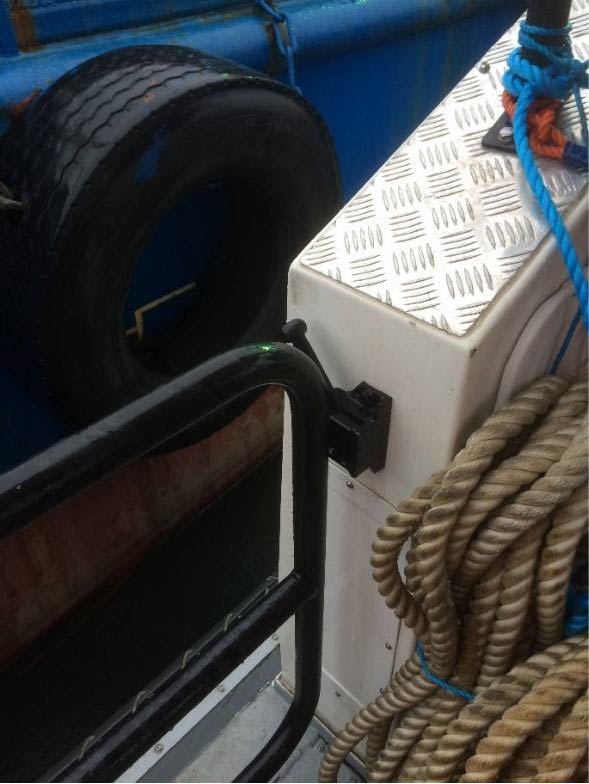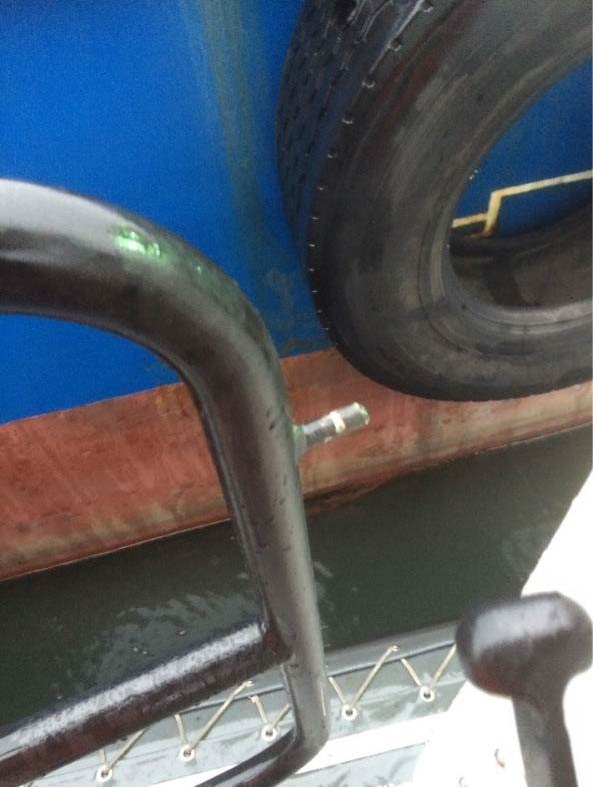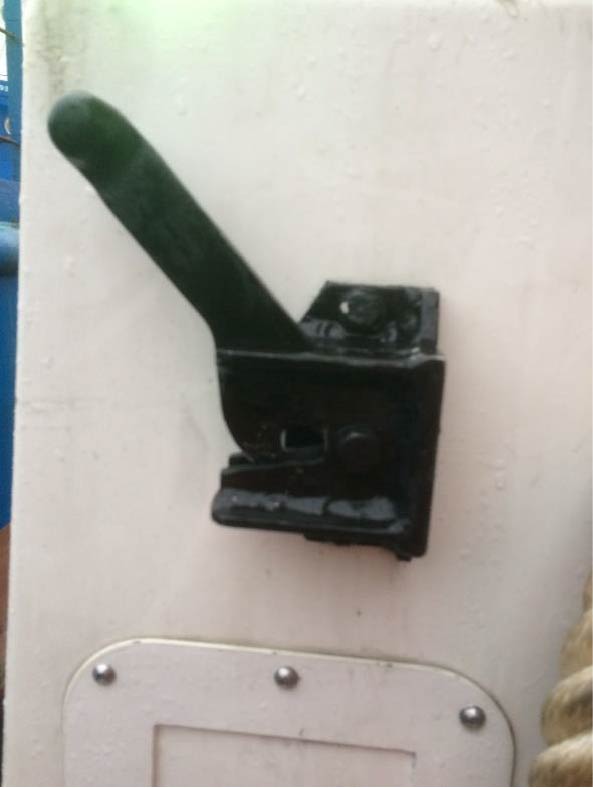Near-miss: Non-fatal man overboard incident
An incident has been brought to IMCA’s attention in which someone fell overboard from a small boat. The incident occurred during the mooring of the daughter craft at a shore-side facility. A crew member leaned against the starboard boarding gate of the diving daughter craft, and the latch on the gate inadvertently opened. As the gate opened the crew member began to fall into the sea. He was able to step through the gate opening and enter the water in a controlled manner rather than falling headlong.
The alarm was immediately raised, assistance given and the crew member was recovered safely within 30 seconds of falling into the water. The crew member was wearing a floatation suit and a life jacket – which self-inflated following immersion. The crew member received no injuries, required no medical or first aid treatment and did not require re-warming. Once recovered inboard, the crew member changed into dry clothes, was issued a dry floatation suit and a replacement lifejacket. He declined a hot drink offered to him. Work was stopped, latches were tied shut and the vessel returned to port and an investigation was started.



The investigation revealed the following:
- The daughter craft was berthed overnight approximately 30 minutes passage from the worksite;
- The gate had been previously checked and the latch confirmed as closed;
- The crew member was wearing the correct Personal Protective Equipment (PPE) – floatation suit, life jacket, hard hat, glasses, gloves and boots – and was inside the barriers on the daughter craft; . The crew member was adjacent to the starboard gate, and this was designed to open outwards. The gate had previously been observed in a closed position. However, the latch had since moved into an open position and this was not observed; . At the time of the incident the daughter craft was being held steady by the Coxswain in calm weather conditions; . The crew member was recovered within 30 seconds. Once recovered, the crew member was given a change of clothes, a dry floatation suit and a replacement life jacket. Spare clothing and PPE (dry floatation suit and spare lifejacket) were all available on board; . This incident showed that there was a good response by the crew members to an emergency situation and that there was a good level of emergency facilities on board the daughter craft;
- The PPE requirements were followed and prevented injury and/or illness to the man overboard. The crew member who fell overboard was wearing a buoyancy (floatation) suit which had the capacity of 100kg. As a result, he had only the bottom half of his body submerged and did not inhale any water or require re-warming;
- General familiarisation training for this daughter craft was given to all crew members. However, the specific reference to checking the boarding gates was not included; . Immediate cause: . The crew member leaned against an unsecured boarding gate which opened allowing said crew member to pass through and enter the water; . Underlying factors: . There was a mechanism failure in the latch of the boarding gate . There was no fail-safe or positive locking mechanism on the gate latches . A missing washer reduced friction on the latching mechanism. This allowed vibrations during transit to and from berth to worksite to cause the latch to raise and the gate to open in an uncontrolled manner . The positioning of the crew member adjacent to the starboard boarding gate.
The following root causes were identified:
- Inadequate latch design:
- There was no secondary protection for the latch
- Owing to a manufacturing fault, the latch very easily opened by vibration, snagging or lightly brushing against it
- The gate opened outwards
- The washer mechanism in the latch on the starboard gate was damaged/loose making the latch handle move from side to side, increasing probability of vibration;
- Positioning of crew members adjacent to the boarding gate:
- The crew member wasn’t aware of the risk of the latch opening
- The risk of the gate opening was not defined in the project hazard inspection and risk analysis, nor in the task based risk assessments or the vessel familiarisation training;
- Inadequate assessment of potential latch failure:
- There was no awareness of the risk of the latch opening
- The vessel was of a brand new build and design
- The vessel had recently been audited and an independent risk assessment of the vessel was undertaken – none of these audits had identified this design fault.
The following actions were taken:
- A temporary secondary mechanism was fitted to both the port and starboard gates (the latches were tied shut during transit) – these were latched and tested for security, to allow vessel operations to restart. A more permanent method of fail-safe locking was engineered and installed;
- A defect report was submitted to the original equipment manufacturer and a safety bulletin was issued advising personnel of the situation, and corrective actions were taken to avoid future recurrence;
- The vessel briefing was also amended to include a requirement for checks on the secondary locking mechanism before departure from the vessel’s berth/mother vessel.
The following recommendations were made:
- The circulation of a bulletin to ensure lessons learnt;
- Consideration to installing a grab rail or a rope on the outside of the daughter craft for a crew member to grab onto in the event of a man overboard situation;
- Consideration to adding a flat plate so that the gate cannot be opened outwards – instead opening inwards and mitigating the risk of the latch failing, the gate opening outwards and another man overboard incident as a result of leaning on the gate;
- The latch-on safety line, or similar running around the daughter craft, should be extended from its current position just aft of midships to a position level with the back deck. This would enable personnel to immediately latch onto the safety line before leaving the back deck.
Members may wish to refer to the following incidents (search words: man overboard):
Safety Event
Published: 5 February 2016
Download: IMCA SF 04/16
IMCA Safety Flashes
Submit a Report
IMCA Safety Flashes summarise key safety matters and incidents, allowing lessons to be more easily learnt for the benefit of all. The effectiveness of the IMCA Safety Flash system depends on Members sharing information and so avoiding repeat incidents. Please consider adding safetyreports@imca-int.com to your internal distribution list for safety alerts or manually submitting information on incidents you consider may be relevant. All information is anonymised or sanitised, as appropriate.
IMCA’s store terms and conditions (https://www.imca-int.com/legal-notices/terms/) apply to all downloads from IMCA’s website, including this document.
IMCA makes every effort to ensure the accuracy and reliability of the data contained in the documents it publishes, but IMCA shall not be liable for any guidance and/or recommendation and/or statement herein contained. The information contained in this document does not fulfil or replace any individual’s or Member's legal, regulatory or other duties or obligations in respect of their operations. Individuals and Members remain solely responsible for the safe, lawful and proper conduct of their operations.
